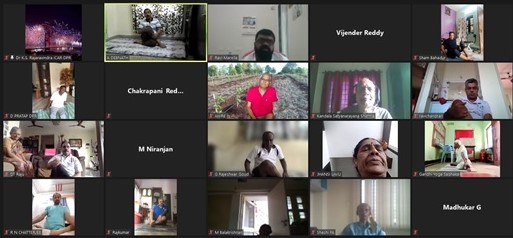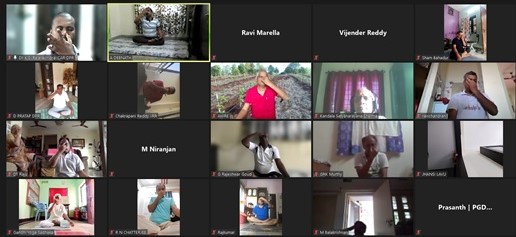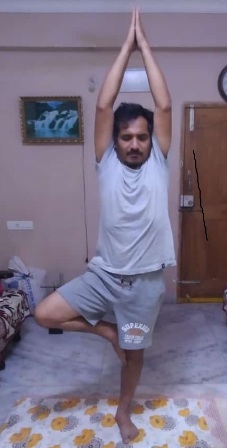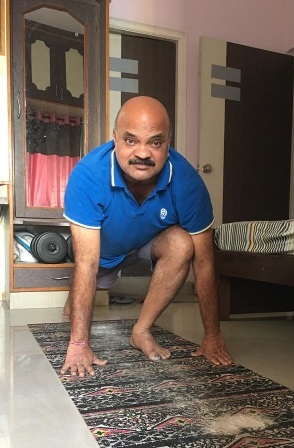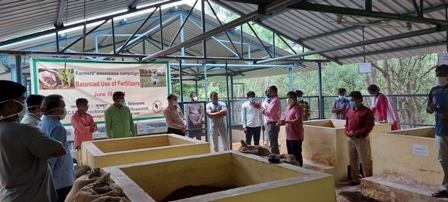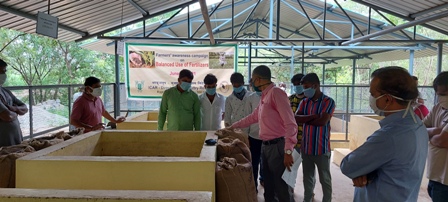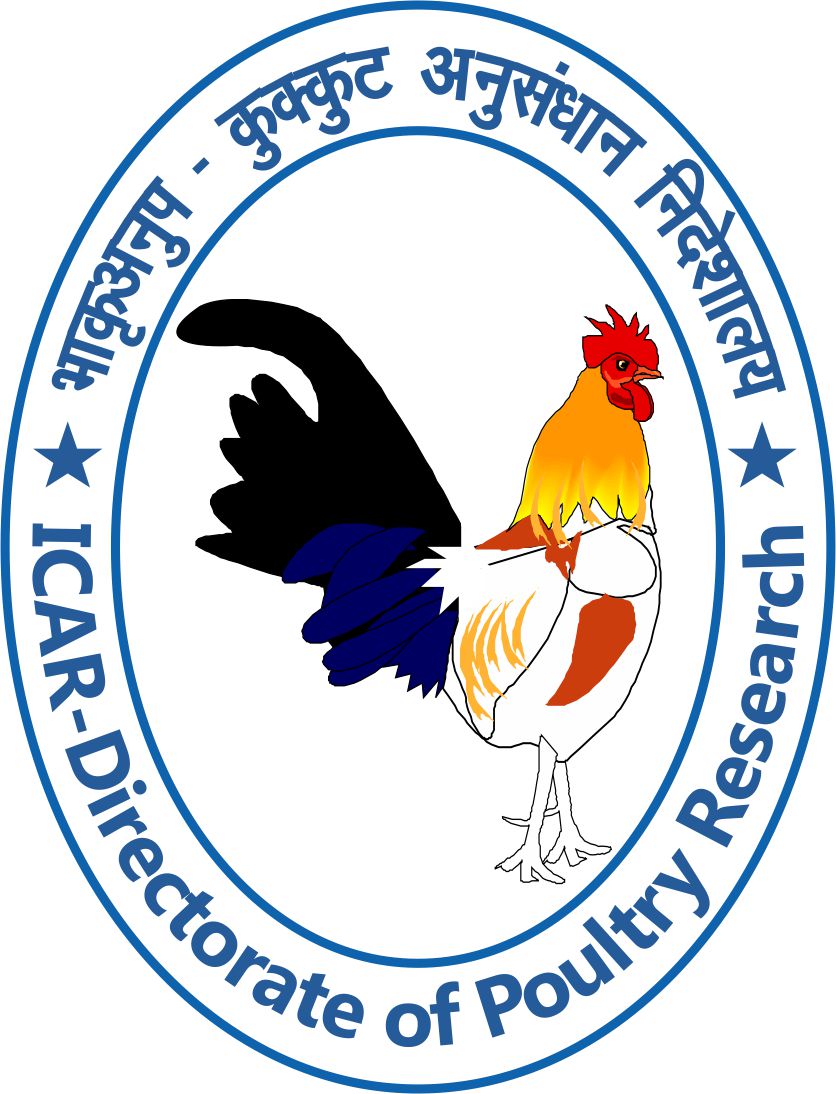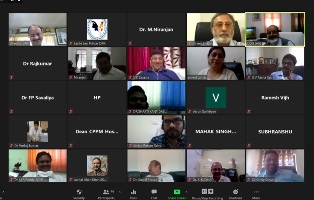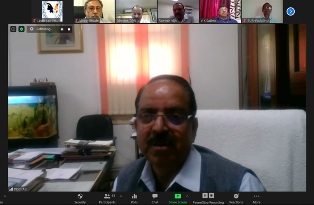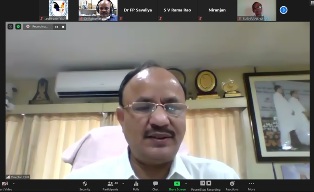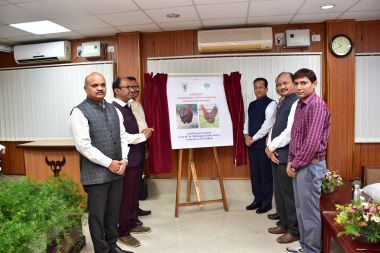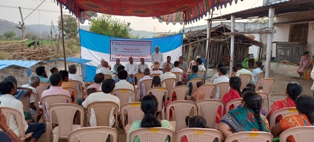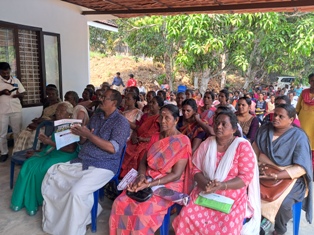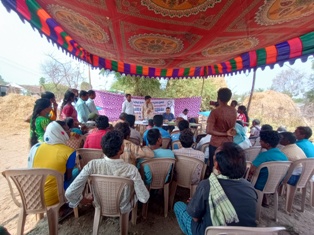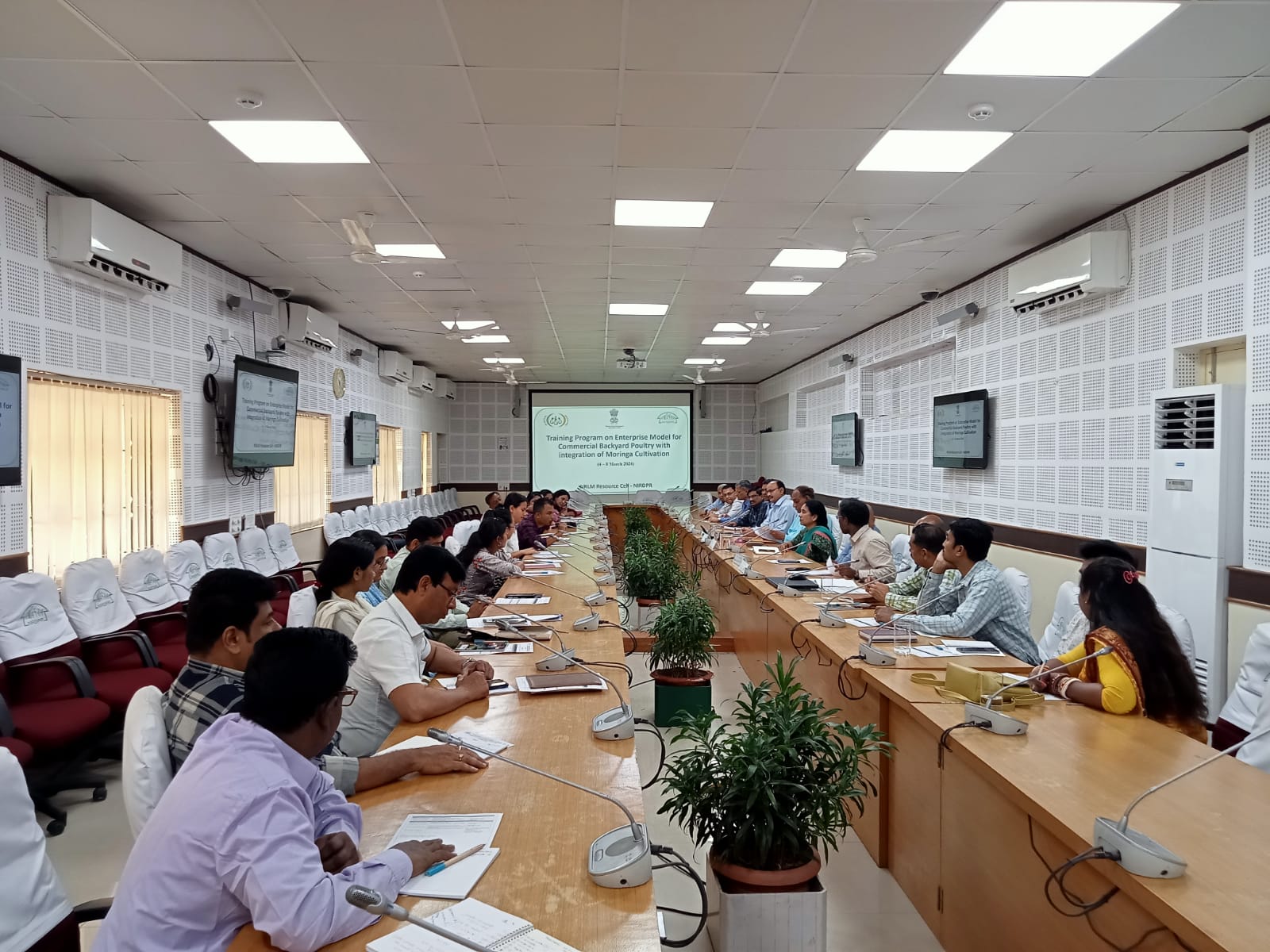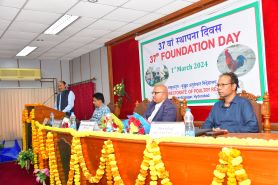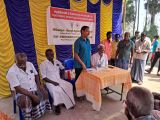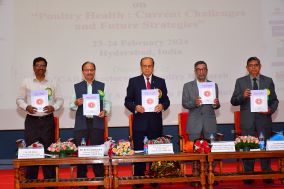Advisory for Poultry Farmers & Consumers during COVID pandemic (English, Hindi and Telugu)
Poultry production particularly the intensive chicken meat production system got big blow during the COVID 19 crises in terms of drastic fall in price of chicken meat (broiler). There are several myths and misnomers created and spread in social media against egg and chicken meat which are scientifically not correct. The farmers realized about INR 30-40/ per kg live broiler weight and against cost of production of INR 85-90/kg live weight. The high cost of production was largely due to severe increase in cost of raw / feed ingredients particularly the protein source i.e. Soybean meal. As the price of the principal protein source in poultry diet i.e. SBM increased the cost of other alternate protein sources were also escalated by the traders of feed ingredients. The fall in demand for poultry meat was due to lack of proper knowledge to the consumers about chicken meat production system. The following issues and probable suggestions may be considered to sustain the growth of poultry production and also ensure the availability of nutritious egg and chicken meat at an affordable price to all the needy population of the country to support their health status and immunity.
v Movement of feed ingredients for livestock feeding (maize, soybean meal and other essential feed additives) will be restricted across the globe. Therefore, emphasis should be in place to attain self sufficiency in producing adequate quantities of feed ingredients required for poultry and other livestock sectors.
v Pressure on the requirement of the major feed ingredients can be reduced to an extent of 5-10% by adapting certain novel technologies developed by both ICAR and State universities. Several potential tools include A. supplementation of microbial NSP enzymes, B. phytase, C. protease (both papain and microbial protease) in poultry diets. Maintain optimum gut health of chicken through adequate bio-security, supplementation of diets with essential oils, organic acids, pre and pro biotics, etc. will also minimize the loss of feed nutrients and subsequent reduction in feed cost per unit meat / egg production.
v In the event of any shortage in production of maize and soybeans, it is advised to utilize respectively broken rice or bajra (up to 30-40% in diet) and cotton seed meal (10-12% in diet) and rape seed meal (5-8% in diet) in poultry diets.
v Linking the supply of poultry produces (egg and chicken meat) with the essential commodity supply chain to all the notified / targeted areas.
v To create awareness to all consumers about egg and chicken meat quality and safety through all relevant government departments. At present there are several myths / false notions among common population about the production and quality / safety of poultry products (egg and chicken meat). Therefore, proper education of common man (consumer) about the health benefits of eggs and chicken meat, production standards, bio-security and health care being practiced, the quality and nutrient specs of poultry diet, which help them to understand and appreciate the safety of poultry products.
v Cleaning, Grading, Packing and Branding of eggs with clear specifications like Date of production, expiry Date, egg weight, protein and essential phospho-lipid content on the pack, will boost up the confidence of consumers.
v Improving the transportation of live birds in closed containers by providing the required micro-environment including temperature, ventilation, oxygen pressure, etc., will improve the image of poultry farming and gain consumer confidence.
v Encourage consumption of processed chicken meat by developing hygienic automatic processing plant, attractive packing with all relevant product information, providing proper cold chain and establishment of trusted brand values.
v Mass campaign to advocate consumption of chicken meat and eggs with different health department wings including human doctors, health / fitness centers, popular sports persons, social workers, etc. will certainly help to increase the consumption of poultry produces without any prejudices.
v Mass vaccination of all backyard poultry birds against Newcastle and some other viral diseases is essential to prevent outbreak of the disease during stress period like severe summer.
=======================
कोविड महामारी के दौरान कुक्कुट किसान एवं उपभोक्ताओं के लिए सलाह
v कोविड 19 संकट के दौरान कुक्कुट मांस (ब्रॉयलर) की कीमतों में भारी गिरावट के कारण कुक्कुट उत्पादन में विशेष रूप से गहन कुक्कुट मांस उत्पादन प्रणाली को बड़ी कठिनाइयों का सामना करना पड़ा। अंडे और कुक्कुट मांस के विरुद्ध सामाजिक माध्यमों में कई तरह के मिथक और भ्रांतियां बनाई और फैलायी गई जो वैज्ञानिक रूप से सही नहीं हैं। किसानों को 85-90 रुपए प्रति किलोग्राम जीवित वजन के उत्पादन लागत पर 30-40 रुपए प्रति किलोग्राम वजन जीवित ब्रॉयलर मात्र प्राप्त हुआ। उत्पादन की उच्च लागत मुख्य रूप से कच्चे/दाना सामग्री एवं विशेष रूप से प्रोटीन स्रोत यानी सोयाबीन आहार की लागत में भारी वृद्धि के कारण रही, चूंकि कुक्कुट आहार में प्रमुख प्रोटीन स्रोत एसबीएम की कीमत में वृद्धि होना है, इसलिए दाना सामग्री के व्यापारियों द्वारा अन्य वैकल्पिक प्रोटीन स्रोतों की लागत भी बढ़ा दी गई। कुक्कुट मांस की मांग में गिरावट का रुख उपभोक्ताओं को कुक्कुट मांस उत्पादन प्रणाली के बारे में उचित ज्ञान की कमी के कारण रहा। कुक्कुट उत्पादन की वृद्धि को बनाए रखने हेतु निम्नलिखित मुद्दों और संभावित सुझावों पर विचार किया जा सकता है और देश के सभी जरूरतमंद लोगों को उनके स्वास्थ्य स्थिति और प्रतिरक्षा क्षमता वृद्धि करने के लिए कम कीमत पर पौष्टिक अंडे और कुक्कुट मांस की उपलब्धता सुनिश्चित करने हेतु भी विचार किया जा सकता है।
v पशुओं को खिलाने के लिए दाना सामग्री (मक्का, सोयाबीन आहार और अन्य आवश्यक दाना योज्यों) की आवाजाही पर दुनिया भर में प्रतिबंधित रहेगी। इसलिए, कुक्कुट और अन्य पशुधन क्षेत्रों के लिए आवश्यक पर्याप्त मात्रा में दाना सामग्री के उत्पादन में आत्मनिर्भरता प्राप्त करने की दिशा में जोर दिया जाना चाहिए।
v भाकृअनुप एवं अन्य राज्य विश्वविद्यालयों द्वारा विकसित कुछ नई तकनीकों को अपनाकर प्रमुख दाना सामग्री की आवश्यकता के दबाव को 5-10% तक कम किया जा सकता है। कुक्कुट आहार में एंटीमाइक्रोबियल एनएसपी एंजाइमों के पूरक, बी.फाइटेज, सी.प्रोटीज (पपैन और माइक्रोबियल प्रोटीज दोनों) जैसे कई संभावित साधन सम्मिलित हैं। पर्याप्त जैव-सुरक्षा, आवश्यक तेलों, कार्बनिक अम्लों, पूर्व और प्रोबायोटिक्स आदि के साथ आहार के पूरक माध्यमों से कुक्कुटों के स्वास्थ्य को बनाए रखने से भी दाना के पोषक तत्वों के नुकसान को कम कर सकता है तथा बाद में यह प्रति यूनिट मांस/अंडा उत्पादन में दाना लागत को भी कम करेगा।
v मक्का एवं सोयाबीन के उत्पादन में किसी भी प्रकार की कमी की स्थिति में, कुक्कुट आहार में क्रमशः कनखी या बाजरा (आहार में 30-40% तक) और कपास बीज आहार (आहार में 10-12%) और रेपसीड दाना (आहार में 5-8%) का उपयोग करने की सलाह दी जाती है।
v सभी अधिसूचित/लक्षित क्षेत्रों में आवश्यक वस्तु आपूर्ति श्रृंखला के साथ कुक्कुट उत्पादों (अंडे एवं कुक्कुट मांस) की आपूर्ति को जोड़ना है।
v सभी संबंधित सरकारी विभागों के माध्यम से उपभोक्ताओं तक अंडे एवं कुक्कुट मांस की गुणवत्ता और सुरक्षा के बारे में सही जागरूकता पैदा करना है। वर्तमान में कुक्कुट उत्पादों (अंडे और कुक्कुट मांस) के उत्पादन और गुणवत्ता/सुरक्षा के बारे में आम जनता के बीच कई प्रकार के मिथक/झूठी धारणाएं फैली हुई हैं। इसलिए, आम आदमी (उपभोक्ता) को कुक्कुट उत्पादों जैसे अंडे और कुक्कुट मांस से स्वास्थ्य लाभ, उत्पादन मानकों, जैव-सुरक्षा और स्वास्थ्य देखभाल, कुक्कुट आहार की गुणवत्ता और पोषक तत्वों के बारे में उचित शिक्षा देना है, जिससे उन्हें उनकी सुरक्षा को समझने और सराहना करने में मदद मिलती है।
v पैक के ऊपर स्पष्ट रूप से उत्पादन की तारीख, समाप्ति तिथि, अंडे का वजन, प्रोटीन और आवश्यक फॉस्फो-लिपिड सामग्री जैसे विनिर्देशों के साथ-साथ अंडों की सफाई, ग्रेडिंग, पैकिंग और ब्रांडिंग की जानकारी उपभोक्ताओं के विश्वास को बढ़ाएगी।
v बंद कंटेनरों में जीवित कुक्कुटों के परिवहन में सुधार हेतु आवश्यक स्वच्छ वातावरण प्रदान कर तापमान, वेंटिलेशन, ऑक्सीजन दबाव आदि सहित से कुक्कुट पालन की छवि में सुधार किया जा सकता है और उपभोक्ताओं का विश्वास भी प्राप्त होगा।
v प्रसंसाधित कुक्कुट मांस की खपत को प्रोत्साहित करने हेतु स्वच्छ स्वचालित संयंत्र विकसित करें, उत्पादन की सभी प्रासंगिक जानकारी देते हुए आकर्षक पैकिंग करें, उचित कोल्डचेन प्रदान करें और विश्वसनीय ब्रांड मूल्यों की स्थापना करें।
v कुक्कुट मांस एवं अंडों की खपत के समर्थन हेतु मानव चिकित्सकों, स्वास्थ्य/फिटनेस सेंटर, लोकप्रिय खिलाड़ी, सामाजिक कार्यकर्ता आदि सहित विभिन्न स्वास्थ्य विभागों के स्कंधों के साथ मिलकर एक जन अभियान चलाया जाए जिससे निश्चित रूप से बिना किसी पूर्वाग्रह के कुक्कुट उत्पादों की खपत को बढ़ाने में मदद मिलेगी।
v अधिक गर्मियों में कुक्कुटों में तनाव की स्थिति के दौरान बीमारी के प्रकोप को रोकने के लिए न्यूकैसल एवं कुछ अन्य विषाणुजनीत बीमारियों के विरुद्ध सभी घर आँगन पालन कुक्कुटों का सामूहिक टीकाकरण करना आवश्यक है।
=======================
COVID మహమ్మారి సమయంలో పౌల్ట్రీ రైతులు & వినియోగదారులు కోసం సలాహలు
కోడి మాంసం (బ్రాయిలర్) ధరలో భారీ పతనం పరంగా కోవిడ్-19 సంక్షోభాల సమయంలో పౌల్ట్రీ ఉత్పత్తి ముఖ్యంగా commercial చికెన్ మాంసం ఉత్పత్తి వ్యవస్థకు పెద్ద దెబ్బ తగిలింది. గుడ్డు మరియు కోడి మాంసాలకు వ్యతిరేకంగా సోషల్ మీడియాలో అనేక అపోహలు మరియు తప్పుడు సమాచారం సృష్టించబడ్డాయి మరియు వ్యాప్తి చెందాయి, ఇవి శాస్త్రీయంగా సరైనవి కావు. రైతులు కిలోకు 30-40 / రూపాయల లైవ్ బ్రాయిలర్ బరువు వచ్చింది, కానీ kg ఉత్పత్తి వ్యయాo INR 85-90 / kg బరువ ఖర్చు వ్యయం. ముడి / ఫీడ్ పదార్ధాల ధర ముఖ్యంగా ప్రోటీన్ మూలం అంటే సోయాబీన్ కేక్ యొక్క తీవ్రమైన పెరుగుదల కారణంగా ఉత్పత్తి వ్యయం అధికoగా ఉంది. పౌల్ట్రీ డైట్లో ప్రిన్సిపల్ ప్రోటీన్ సోర్స్ యొక్క ధర అనగా SBM ఇతర ప్రత్యామ్నాయ ప్రోటీన్ వనరుల ధరను వ్యాపారులు పెంచారు.
కోడి మాంసం ఉత్పత్తి విధానం గురించి వినియోగదారులకు సరైన అవగాహన లేకపోవడమే పౌల్ట్రీ మాంసం కోసం డిమాండ్ తగ్గడానికి ప్రధాన కారణం. పౌల్ట్రీ ఉత్పత్తి వృద్ధిని కొనసాగించడానికి మరియు దేశంలోని పేద ప్రజలందరికీ వారి ఆరోగ్య స్థితి మరియు రోగనిరోధక శక్తికి తోడ్పడటానికి సరసమైన ధర వద్ద పోషకమైన మరియు రుచికరమైన గుడ్డు మరియు కోడి మాంసం లభ్యతను నిర్ధారించడానికి ఈ క్రింది సమస్యలు మరియు సంభావ్య సూచనలు పరిగణించబడతాయి.
· పశువుల దాణా (మొక్కజొన్న, సోయాబీన్ cake మరియు ఇతర ముఖ్యమైన ఫీడ్ సంకలనాలు) కోసం ఫీడ్ పదార్థాల కదలిక ప్రపంచవ్యాప్తంగా పరిమితం చేయబడుతుంది. అందువల్ల, పౌల్ట్రీ మరియు ఇతర పశువుల రంగాలకు అవసరమైన ఫీడ్ పదార్థాలను తగినంత పరిమాణంలో ఉత్పత్తి చేయడంలో స్వయం సమృద్ధి సాధించడానికి ప్రాధాన్యత ఇవ్వాలి.
· ICAR మరియు రాష్ట్ర పశువైద్య విశ్వవిద్యాలయాలు అభివృద్ధి చేసిన కొన్ని సాంకేతిక పరిజ్ఞానాన్ని అనుసరించడం ద్వారా ప్రధాన ఫీడ్ పదార్ధాల అవసరాలపై ఒత్తిడి 5-10% వరకు తగ్గించవచ్చు. A. పౌల్ట్రీ డైట్స్లో సూక్ష్మజీవుల ఎన్ఎస్పి ఎంజైమ్లు, బి. ఫైటాస్, సి. ప్రోటీజ్ (పాపైన్ మరియు సూక్ష్మజీవుల ప్రోటీజ్డూ) యొక్క అనేక అనుబంధ సాధనాలు ఉన్నాయి.
· తగినంత బయో-సెక్యూరిటీ ద్వారా చికెన్ యొక్క వాంఛనీయ ప్రేగు ఆరోగ్యాన్ని కాపాడుకోండి, సుగంధ నూనెలు, సేంద్రీయ ఆమ్లాలు, ప్రీ మరియు ప్రో బయోటిక్స్ మొదలైన వాటితో ఆహారం తీసుకోవడం కూడా ఫీడ్ పోషకాల నష్టాన్ని తగ్గిస్తుంది మరియు తరువాత యూనిట్ మాంసం / గుడ్డు ఉత్పత్తికి ఫీడ్ ఖర్చు తగ్గుతుంది.
· మొక్కజొన్న మరియు సోయాబీన్ల ఉత్పత్తిలో ఏదైనా కొరత ఏర్పడితే, వరుసగా విరిగిన బియ్యం లేదా సజ్జలు (ఆహారంలో 30-40% వరకు) మరియు పత్తి విత్తన కేక్ (ఆహారంలో 10-12%), బియ్యం నుండి డిడిజిఎస్ మరియు రేప్ సీడ్ కేక్ ఉపయోగించాలని సూచించారు. పౌల్ట్రీ డైట్స్లో (ఆహారంలో 5-8%).
· పౌల్ట్రీ ఉత్పత్తిని (గుడ్డు మరియు కోడి మాంసం) అన్ని సరుకుల సరఫరా గొలుసుతో నోటిఫైడ్ / లక్షిత ప్రాంతాలకు అనుసంధానించడం.
· అన్ని సంబంధిత ప్రభుత్వ విభాగాల ద్వారా గుడ్డు మరియు కోడి మాంసం నాణ్యత మరియు భద్రత గురించి వినియోగదారులందరికీ అవగాహన కల్పించడం. ప్రస్తుతం పౌల్ట్రీ ఉత్పత్తుల (గుడ్డు మరియు కోడి మాంసం) ఉత్పత్తి మరియు నాణ్యత / భద్రత గురించి సాధారణ ప్రజలలో అనేక అపోహలు / తప్పుడు భావనలు ఉన్నాయి. అందువల్ల, గుడ్లు మరియు కోడి మాంసం యొక్క ఆరోగ్య ప్రయోజనాలు, ఉత్పత్తి ప్రమాణాలు, జీవ భద్రత మరియు ఆరోగ్య సంరక్షణ, పౌల్ట్రీ ఆహారం యొక్క నాణ్యత మరియు పోషక విలువలు గురించి సామాన్యుల (వినియోగదారు) సరైన విద్య, ఇది భద్రతను అర్థం చేసుకోవడానికి మరియు అభినందించడానికి సహాయపడుతుంది.
· పౌల్ట్రీ ఉత్పత్తుల ఉత్పత్తి తేదీ, గడువు తేదీ, గుడ్డు బరువు, ప్రోటీన్ మరియు ప్యాక్లోని అవసరమైన ఫాస్ఫో-లిపిడ్ కంటెంట్ వంటి స్పష్టమైన వివరాలతో గుడ్లను శుభ్రపరచడం, గ్రేడింగ్ చేయడం, ప్యాకింగ్ చేయడం మరియు బ్రాండింగ్ చేయడం వినియోగదారుల విశ్వాసాన్ని పెంచుతుంది.
· తగినంత ఉష్ణోగ్రత, కాంతి, గాలి, ఆక్సిజన్ పీడనం మొదలైన వాటితో సహా అవసరమైన సూక్ష్మ వాతావరణాన్ని అందించడం ద్వారా క్లోజ్డ్ కంటైనర్లలో జీవిన్చి ఉన్నా పక్షులరవాణాను మెరుగుపరచడం పౌల్ట్రీ పెంపకం యొక్క ఇమేజ్ను మెరుగుపరుస్తుంది మరియు వినియోగదారుల విశ్వాసాన్ని పొందుతుంది.
· పరిశుభ్రమైన ఆటోమేటిక్ ప్రాసెసింగ్ ప్లాంట్, అన్ని సంబంధిత ఉత్పత్తి సమాచారంతో ఆకర్షణీయమైన ప్యాకింగ్, సరైన కోల్డ్ చైన్ అందించడం మరియు విశ్వసనీయ బ్రాండ్ విలువలను స్థాపించడం ద్వారా ప్రాసెస్ చేసిన కోడి మాంసం వినియోగాన్ని ప్రోత్సహించండి.
· మానవ వైద్యులు, ఆరోగ్యం / ఫిట్నెస్ కేంద్రాలు, ప్రసిద్ధ క్రీడాకారులు, సామాజిక కార్యకర్తలు వంటి వివిధ ఆరోగ్య శాఖ విభాగాలతో కోడి మాంసం మరియు గుడ్ల వినియోగాన్ని ఎటువంటి పక్షపాతం లేకుండా సమర్థించాలన్న మాస్ క్యాంపెయిన్ పౌల్ట్రీ ఉత్పత్తిని పెంచడానికి ఖచ్చితంగా సహాయపడుతుంది.
· తీవ్రమైన వేసవి వంటి ఒత్తిడి కాలంలో వ్యాధి వ్యాప్తి చెందకుండా ఉండటానికి కొక్కర వ్యాధి మరియు కొన్ని ఇతర వైరల్ వ్యాధులకు వ్యతిరేకంగా అన్ని పెరటి పౌల్ట్రీ పక్షులకు మాస్ టీకాలు వేయడం అవసరం.
Â
=======================
